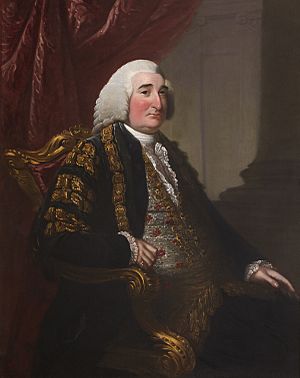Thomas Hay, 9th Earl of Kinnoull facts for kids
Quick facts for kids
The Earl of Kinnoull
|
|
|---|---|

Portrait by David Martin
|
|
| Lord Commissioner of the Treasury | |
| In office 1754–1755 |
|
| Member of Parliament for Cambridge |
|
| In office 1741–1758 |
|
| Preceded by | Sir John Hynde Cotton, Bt |
| Succeeded by | Soame Jenyns |
| Personal details | |
| Born | 4 July 1710 |
| Died | 27 December 1787 (aged 77) |
| Spouse |
Constantia Ernlie
(m. 1741; died 1753) |
| Parents |
|
Thomas Hay, the 9th Earl of Kinnoull (born July 4, 1710, died December 27, 1787), was an important Scottish nobleman, a British politician, and a smart scholar. From 1719 to 1758, he was known as Viscount Dupplin.
Contents
Early Life and Education
Thomas Hay was the oldest son of George Hay, 8th Earl of Kinnoull, and Abigail Harley. His mother was the daughter of Robert Harley, 1st Earl of Oxford and Earl Mortimer.
He went to school at Westminster School. After that, he studied at Christ Church, Oxford University.
His Marriage and Family
On June 12, 1741, Thomas Hay married Constantia Ernle. They got married at Oxford Chapel in Marylebone. Constantia was the only daughter of John Kyrle Ernle. Her family lived at Whetham House, near Calne, Wiltshire.
Constantia's great-grandfather was Sir John Ernle. He was a very important person. He worked as the Chancellor of the Exchequer for many years. This job is like being the country's main money manager.
Thomas and Constantia had one son. He was born on August 12, 1742. Sadly, their son died young, on October 14, 1743. Constantia herself passed away in July 1753. She was buried in Calne.
When his father died on July 28, 1758, Thomas became the 9th Earl of Kinnoull.
Political Career
Thomas Hay started his political journey as Viscount Dupplin. In 1736, he was chosen to represent Scarborough in Parliament. However, his election was later cancelled.
From 1741 to 1758, he served as a Member of Parliament (MP) for Cambridge. As an MP, he slowly became more and more important. In his last two terms, he led the committee that handled special rules and elections.
In 1741, he became a commissioner for taxes in Ireland. In 1746, he was made a lord of trade and plantations. This meant he helped with trade and setting up new colonies.
In 1754, a powerful leader named Thomas Pelham-Holles, 1st Duke of Newcastle made him a Lord of the Treasury. This was another important role in managing the country's money. From 1755 to 1757, he also worked as a joint Paymaster of the Forces. This job involved paying the army.
Friends and Influence
Thomas Hay was well-known among politicians and writers. He was friends with many important people. These included Philip Yorke, 1st Earl of Hardwicke and William Murray, 1st Earl of Mansfield. He was also friends with the Archbishop of Canterbury, Thomas Secker.
He even knew the famous poet Alexander Pope. Pope used him as an example for a character in one of his poems.
From 1758 to 1762, he was the Chancellor of the Duchy of Lancaster. This was a high-ranking government job. In 1759, he went to Portugal as a special envoy. This means he was sent to represent Britain there. He came back the next year.
In 1762, the Duke of Newcastle resigned. Thomas Hay told King George III he would support any new minister the King chose. However, when another important leader, the William Cavendish, 4th Duke of Devonshire, was fired, Thomas Hay resigned too. He did this because of his strong friendship with Devonshire.
After this, he decided to retire to the countryside. His last official job was as Chancellor of the University of St Andrews. He held this position from 1765 until he died on December 27, 1787. He was buried in Aberdalgie.
His nephew, Robert Hay-Drummond, became the next Earl.
Lasting Legacies
The 9th Earl left behind some important things.
Kinnoull Tower
He built a small castle near the highest point of Kinnoull Hill. Its tower looked out over the River Tay. He got the idea for this castle from the castles he saw along the Rhine River in Germany. He had seen them during his "Grand Tour," which was a trip young noblemen took around Europe.
The famous writer Jane Austen wrote about Kinnoull Tower in her story Lesley Castle. She described it in 1790, after visiting the area. She wrote:
I continue secluded from Mankind in our old and Mouldering Castle, which is situated two miles from Perth on a bold projecting rock, and commands an extensive view of the Town and its delightful Environs... You can form no idea sufficiently hideous, of its dungeon like form. It is actually perched on a Rock to appearance so totally inaccessible, that I expected to have been pulled up by a rope.
Today, it's much easier to reach Kinnoull Tower. There's a winding path through Kinnoull Hill Woodland Park.
Perth Bridge
Another lasting legacy from the 9th Earl is the Perth Bridge over the River Tay. Locals call it "the Auld Brig," which means "the Old Bridge" in their dialect. He helped pay for this bridge. Building started in 1766 and finished in 1771.
Places Named After Him
Some places in America were named after him. Duplin County, North Carolina, got its name from Viscount Dupplin. This was his title when he worked on the Board of Trade and Plantations in the 1740s. Also, Lempster, New Hampshire, was briefly called Dupplin from 1753 to 1767.

